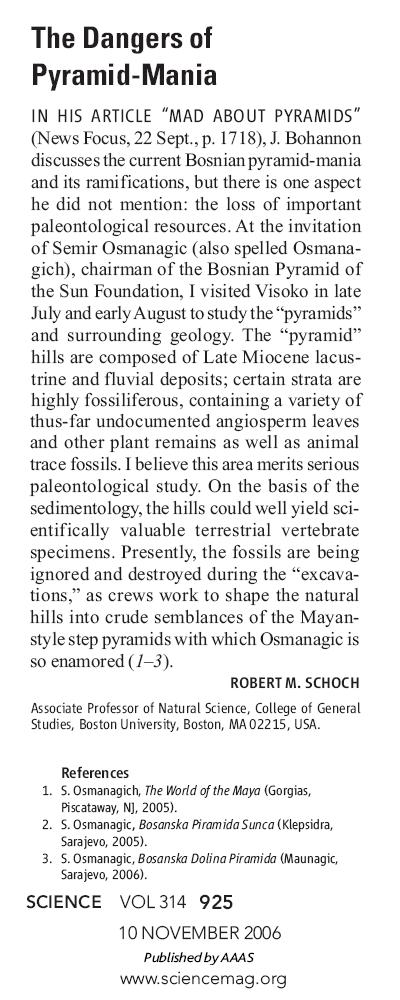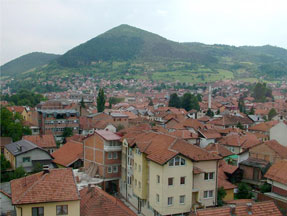
The Bosnian Pyramid Phenomenon
By Robert M. Schoch
Boston University
Note: In Addition to the text below, my opinions on the Bosnian Pyramid Phenomenon are cited in an article published in the December 2009 issue of Smithsonian magazine. See: www.smithsonianmag.com/history-archaeology/The-Mystery-of-Bosnias-Ancient-Pyramids.html
The piece below is a slightly modified version of an article that was published in the September 2006 issue (Volume 1, Issue 8) of The New Archaeology Review. I maintain my conviction that there are NO pyramids at Visoko, Bosnia. Rather, all the so-called pyramids are the result of natural geological processes and phenomena that are currently being “excavated” (i.e., modified) to look like pyramids.
A Couple of other Comments:
Many non-geologists have been impressed by the “regularity” of certain features at Visoko, and from these regularities have argued that they cannot be natural, but rather must be manmade. One should realize that geology is full of regularities, from the precise forms of mineral crystals, to the common occurrence of cyclical sedimentation (which at Visoko accounts for the regularity of the sandstone layers occurring at intervals on the order of a meter in many places, separated by layers of mudstones and shales - - a name commonly applied to such a geological feature is “cyclothem” and cyclothems represent natural depositional cycles).

Also, certain “pyramid experts,” including one from Egypt who has been disavowed by Dr. Zahi Hawass, the former Secretary General of Egypt’s Supreme Council of Antiquities, have claimed that there are “primitive” pyramids at Visoko. I have looked at the exact same rocks and sites firsthand, and I believe that all of the so-called pyramid features are easily accountable for in terms of natural geological processes and features. I have also spent many years studying pyramids in Egypt and elsewhere, and I feel I have a good handle on the features that distinguish a genuine pyramid. (As a side note, Dr. Zahi Hawass, who if anyone can claim to be an expert on pyramids, it is certainly him, has clearly stated that based on the evidence he has seen the so-called Bosnian pyramids are natural formations. Admittedly the opinion of Dr. Hawass is based on second-hand evidence, since to my knowledge he has not visited the so-called Bosnian pyramids, but I believe it should still be taken into consideration by those who claim there are genuine pyramids at Visoko.)
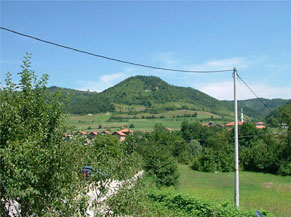
The article from The New Archaeology Review follows:
Semir Osmanagic announced it to the press with fiery conviction: “The history of civilization has to be rewritten,” he said. “Bosnia will become a giant on the world archeological map” (quoted from a 4 May 2006 Reuters Report By Daria Sito-Sucic). On the outskirts of the Bosnian town of Visoko, half an hour drive northwest of Sarajevo, Osmanagic claimed there were two monstrous pyramids (dubbed the “Pyramid of the Sun” and the “Pyramid of the Moon”), and perhaps several smaller pyramids as well. Even the prestigious New York Times picked up the story: “Some See a Pyramid to Hone Bosnia’s Image. Others See a Big Hill.” (New York Times, 15 May 2006, page A8). At least four different websites were devoted to the “Bosnian Pyramids.” The supposed pyramids formed the stuff of heated debate at other websites (most notably, perhaps, that of the Archaeological Institute of America), chat-rooms, and blogs across the Internet.
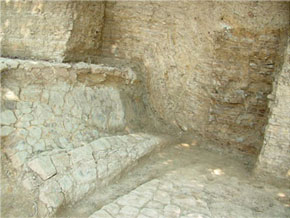
Were they really man-made pyramids, perhaps dating back thousands of years? (Some advocates placed them as much as 12,000 or 14,000 years in the past.) Now covered with soil, trees, and other vegetation, Bosnian pyramid buffs argued that the “pyramids” needed to be excavated to reveal their glory and prove that Bosnia, of all places, was the virtual origin of, well not just pyramids, but perhaps even civilization. Tunnels reputedly associated with the pyramids were said to contain cryptic engravings that could just possibly be the oldest writing ever discovered. Detractors, on the other hand, saw the so-called pyramids as simply interesting, but perfectly and completely natural, geomorphologic features - - that is, they are just big hills. Some even argued that the whole notion of the Bosnian pyramids was not just a mistake or an ill-conceived notion, but a downright hoax designed to bring prestige, fame, power, and money to Bosnia, Visoko, and the head of the Bosnian Pyramid of the Sun Foundation, the Bosnian-American (he now resides in Houston much of the time where he maintains a business) Semir (“Sam”) Osmanagic (also spelled Osmanagich). Indeed, on 12 May 2006, National Geographic ran an article on their website titled “Pyramid in Bosnia -- Huge Hoax or Colossal Find?” It did not help Osmanagic’s case, at least in the eyes of the traditional academic community, that he is an advocate of “alternative history,” and his numerous books (mostly published in Bosnian, the one widely available in English, is titled The World of the Maya) almost seem purposefully written to provoke the ire of traditional archaeologists.
Having more than a casual interest in ancient pyramids, I wanted to see first-hand what all the pyramid fuss in Bosnia was about. If there really was a huge pyramid, larger than the Great Pyramid of Egypt, in Bosnia, then I wanted the opportunity to study it. On the other hand, if there were no pyramids in Bosnia, that would be important to know too. So I traveled to Bosnia during July and August 2006.
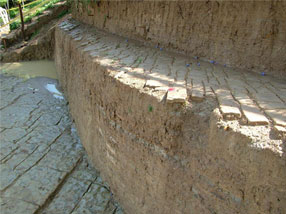
The afternoon I arrived in Bosnia, Osmanagic insisted on taking me straightaway to the so-called “Pyramid of the Sun.” I observed the excavated areas of huge stone blocks; blocks that I was told were most definitely not natural. Clearly, Osmanagic insisted, they were man-made concrete blocks that cannot be explained geologically, put into place with a sophisticated ancient technology that has now been lost. Amazingly, he explained, the “concrete” blocks proved to be harder and more durable than any modern concretes or cements. But he and I were apparently seeing different things, perhaps viewing an entirely different world. Where he saw concrete blocks and human intervention, I saw only perfectly natural sandstones and conglomerates that had broken into larger or smaller blocks due both to tectonic stresses and gravity slumping. For a week and a half this seemed to be the dominant theme: Osmanagic and others who worked with and for him insisting that this or that feature can never occur in nature, and thus must be artificial and human-made, versus me finding a perfectly reasonable geological explanation for each of the same features.
I had a chance to see the Visoko region from the air, and this only further convinced me that the features are natural hills and not artificial pyramids.
The geology around Visoko is incredibly rich, and I suggested to Osmanagic that, in lieu of “pyramids,” he might redefine his “Archaeological Park” as a “Geological-Archaeological Park” and focus more on the geology. Visocica Hill (the one dubbed “Pyramid of the Sun”) and Pljesevica Hill (“Pyramid of the Moon”) are composed of layers of sandstone, clay, mudstone, siltstone, and conglomerates apparently deposited in an ancient lake and river system during Miocene times (about 5.3 to 23 million years ago). The rocks have been tilted and bent due to tectonic stresses (this can be seen in a photo above, which shows a natural folding and faulting in the rocks composing the side of a so-called pyramid in Visoko). The tectonic forces plastically deformed the clays and mudstones, but the sandstones and conglomerates broke into semi-regularly shaped pieces that Osmanagic and his team have excavated in numerous places, interpreting them as “pavements,” “terraces,” “concrete blocks,” “foundation stones,” and so forth. Interestingly, and tellingly, the sizes of the sandstone and conglomerate blocks found are a function of the thickness of the original rock layers. Thin sandstone layers, stressed tectonically, broke into small blocks while thick and durable conglomerate layers broke into massive blocks. This is exactly the pattern expected among natural rock formations. The sandstones also typically preserve various sedimentary and depositional features, such as ripple marks and the traces of ancient burrowing animals. These same rocks are also rich in paleontology. In some of the sandstone layers, and in many of the mudstone layers, I found large accumulations of fossil leaf debris and even some fairly complete Miocene fossil leaves. I believe that the real treasure of Visoko may be a huge fossil biota just waiting to be uncovered, not some imaginary pyramids.
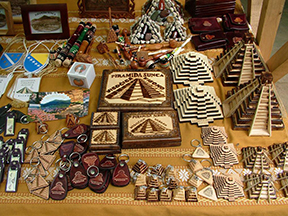
While wondering the streets of Visoko, being offered all sorts of pyramid souvenirs, from tee shirts to copper plates bearing depictions of the Bosnian Pyramid of the Sun (stylistically rendered either as a stepped Mayan-style pyramid or, less frequently, as a smooth-sided Giza-style pyramid), I continued to hope against hope that I could find some “truth” underlying the “pyramid mania” that has gripped the region. One last possibility might be the evidence of the reputed tunnels found in the area that supposedly connect one pyramid to another. I had the opportunity to explore one tunnel that is currently open; to put it mildly, I was disappointed with what I saw. The tunnel had clearly been entered and modified in recent times, as evidenced by the graffiti found in places, the collapsed ceilings and walls, and the stories that the Yugoslavian army (Bosnia and Herzegovina was part of the former Yugoslavia) had once used the tunnels for military purposes, and possibly purposefully destroyed parts of them. If this was an ancient tunnel, it was difficult to tell now. The much-touted “ancient inscriptions” seem not to be ancient at all. I was told by a reliable source that the inscriptions were not there when members of the “pyramid team” initially entered the tunnels less than two years ago. The “ancient inscriptions” had been added since, perhaps non-maliciously, or perhaps as a downright hoax.
So, no pyramids, but there are many fascinating and genuine archaeological wonders in Bosnia. On the summit of Visocica Hill, which overlooks Visoko, are the remains of a medieval fort built on top of Roman ruins, and there is also evidence of Neolithic occupation of the hill, dating back perhaps 5,000 years. While in Bosnia I also visited megalithic ruins attributed to the Illyrians (circa 4th century BCE), a possible Paleolithic cave (unfortunately, I had neither the time nor equipment to enter it; I would love to return and explore it), and fascinating medieval cemetery monuments to the dead.
Despite my failure to validate the Bosnian pyramid dreams, Semir Osmanagic and all the members of the Bosnian Pyramid of the Sun Foundation were most gracious hosts. They spared no effort to make sure that I could view all aspects of the so-called pyramids, even arranging for me to take a short airplane ride to see them from the air. Bosnia is a beautiful country with amazing scenery and a rich history. The people are extremely friendly and hospitable, and Bosnia exhibits a wonderful mixture of Western (Austro-Hungarian) and Eastern (Turkish and Islamic) traditions. Even in the absence of pyramids, it is certainly a country worth visiting.
-----
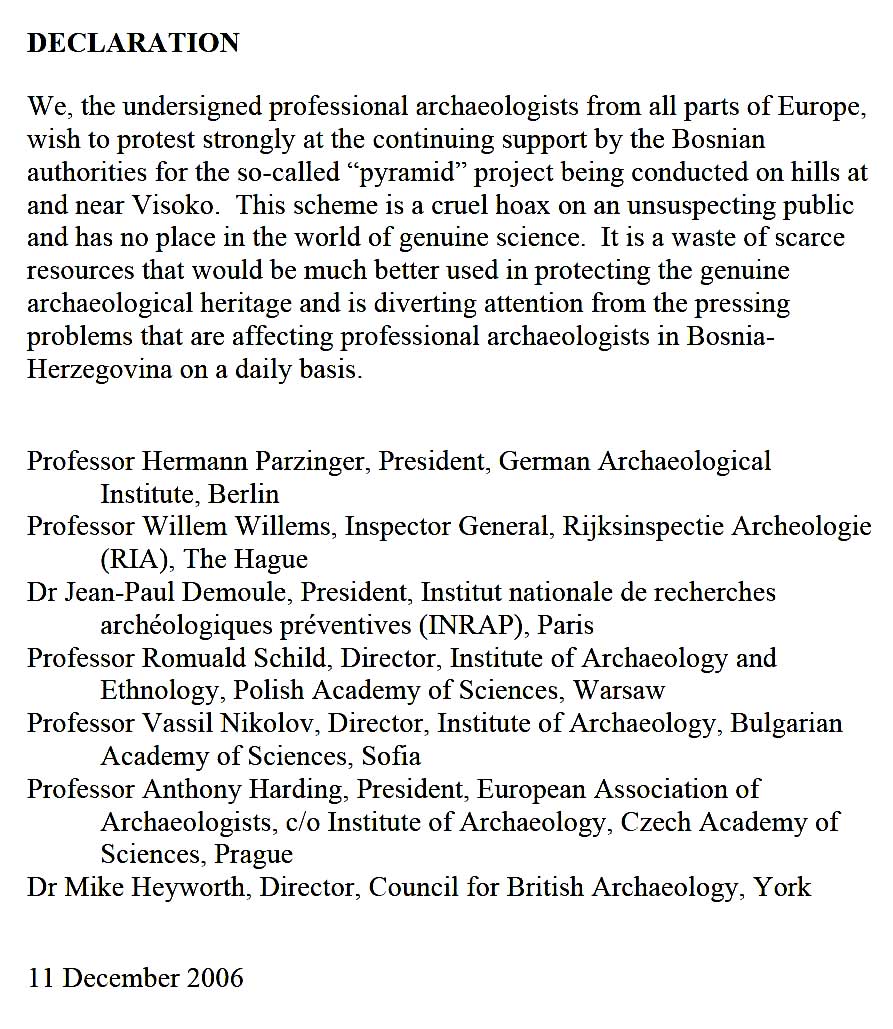
FYI: Members of the European Association of Archaeologists issued a formal statement concerning the matter of the so-called "Bosnian Pyramids". An image of the Declaration is posted alongside this text. For a clearer version of the statement, here is a PDF you can download.
The Bosnian Pyramids: The Biggest Hoax in History?
In April of 2011 I was interviewed by a Dutch production company for a documentary about the Bosnian pyramids. Here is a link to the piece, posted to YouTube.
